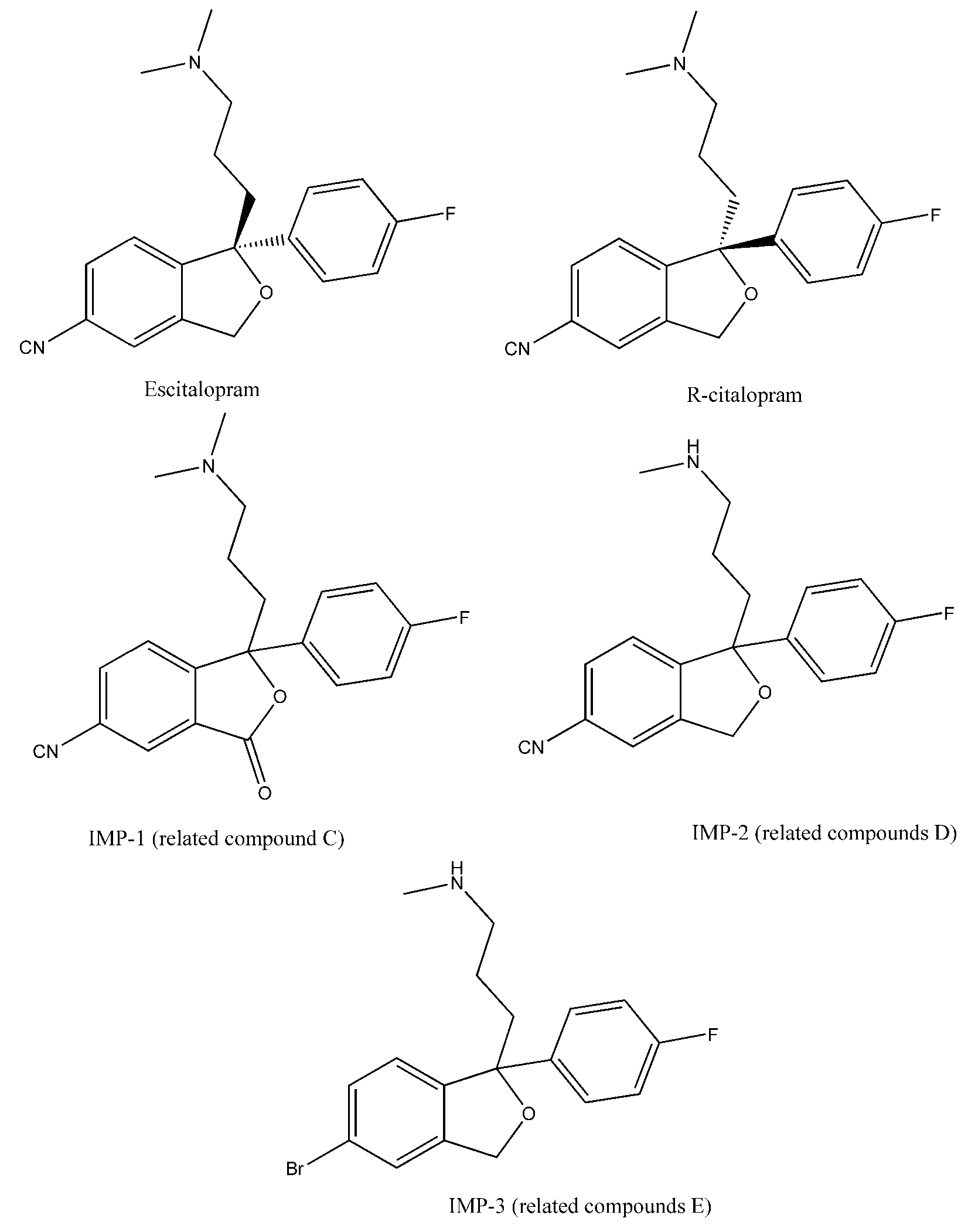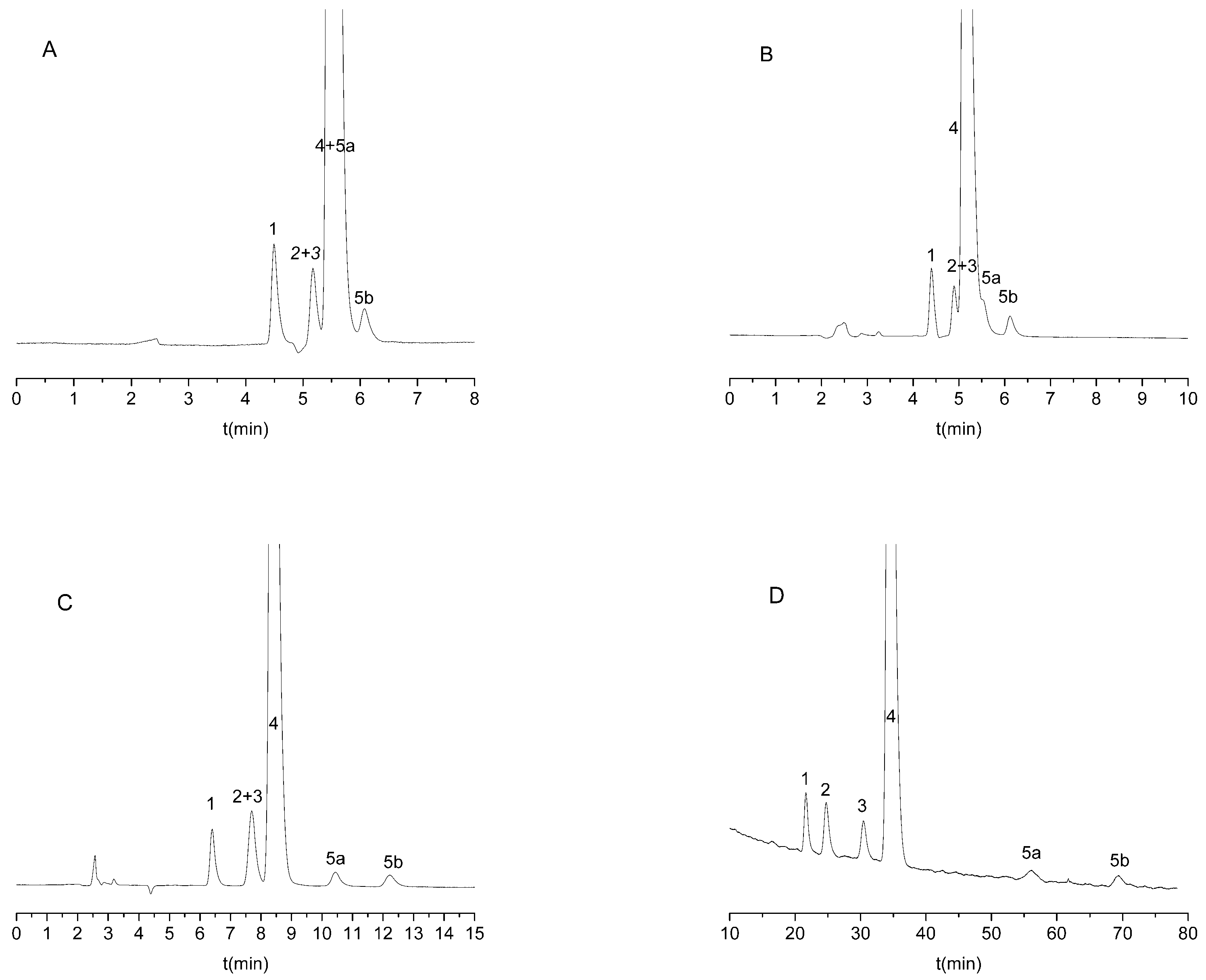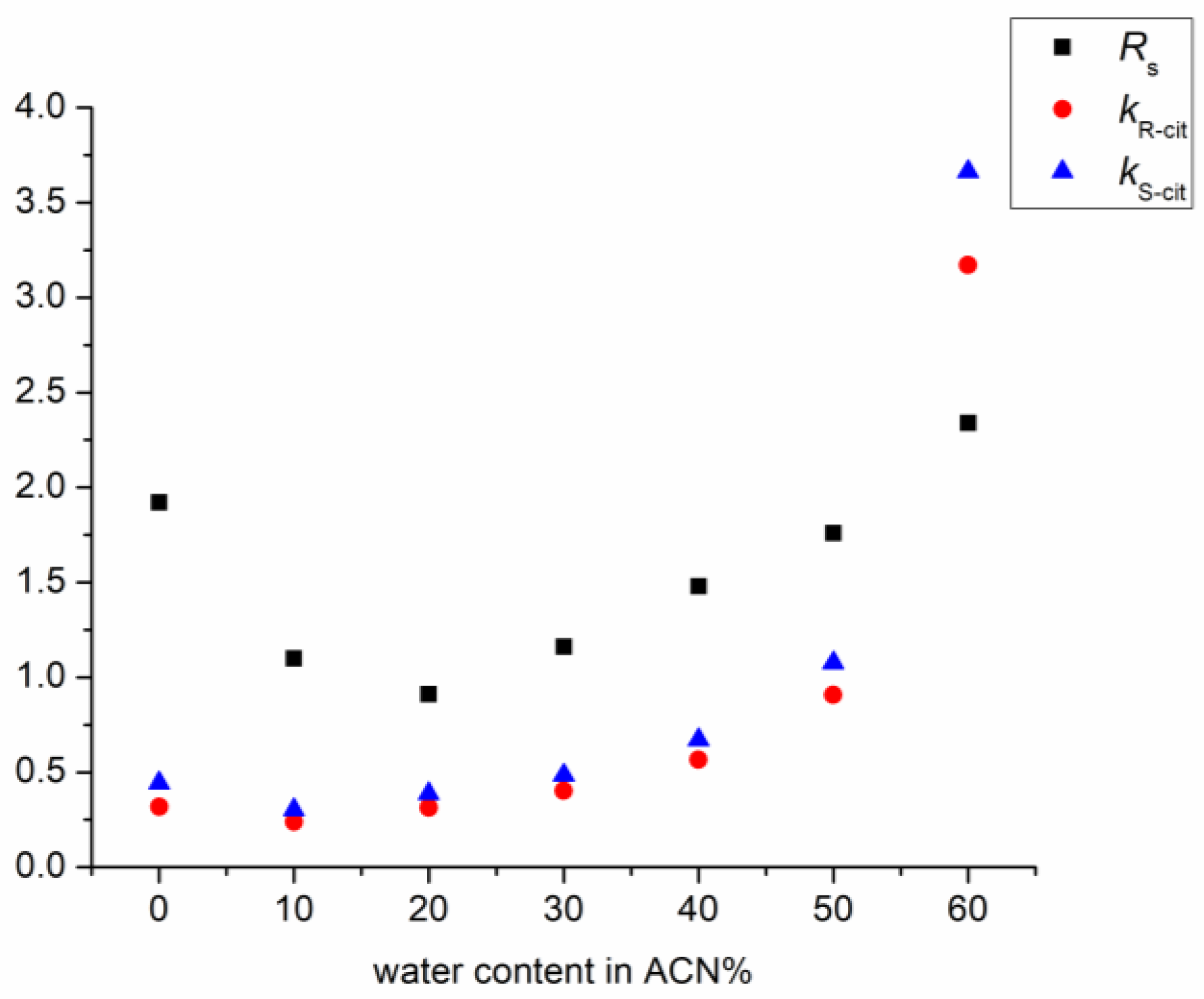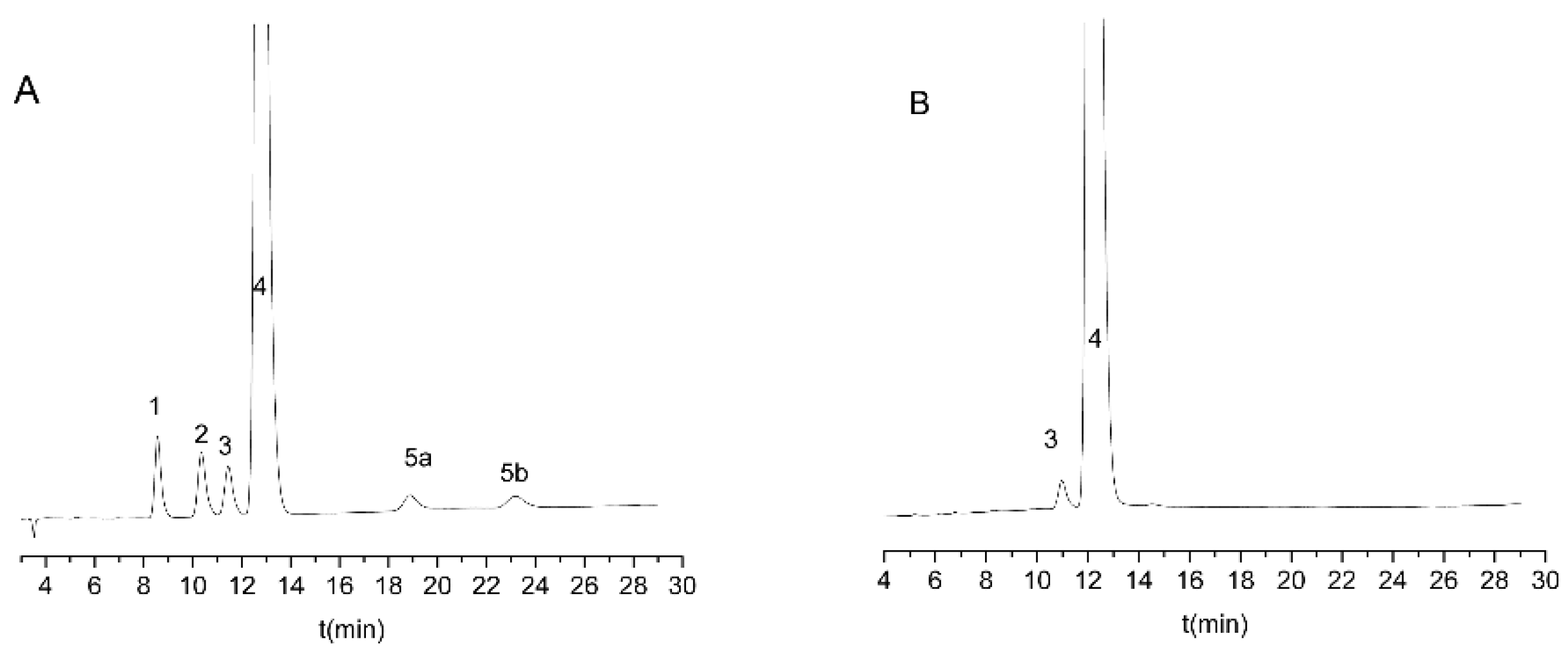Simultaneous Determination of Escitalopram Impurities including the R-enantiomer on a Cellulose tris(3,5-Dimethylphenylcarbamate)-Based Chiral Column in Reversed-Phase Mode
Abstract
:1. Introduction
2. Results and Discussion
2.1. Method Development
2.2. Method Validation and Application
2.3. Thermodynamic Study
3. Materials and Methods
3.1. Materials
3.2. LC-UV Analysis
4. Conclusions
Supplementary Materials
Author Contributions
Funding
Institutional Review Board Statement
Informed Consent Statement
Data Availability Statement
Conflicts of Interest
References
- Garnock-Jones, K.P.; McCormack, P.L. Escitalopram: A review of its use in the management of major depressive disorder in adults. CNS Drugs 2010, 24, 769–796. [Google Scholar] [CrossRef] [PubMed]
- Zhong, H.; Haddjeri, N.; Sánchez, C. Escitalopram, an antidepressant with an allosteric effect at the serotonin transporter—A review of current understanding of its mechanism of action. Psychopharmacology 2012, 219, 1–13. [Google Scholar] [CrossRef] [PubMed]
- Ebert, B.; Reines, E.H.; Braestrup, C. Escitalopram versus citalopram: The surprising role of the R-enantiomer. Psychopharmacology 2004, 174, 163–176. [Google Scholar] [CrossRef]
- Ferencz, E.; Kovács, B.; Boda, F.; Foroughbakhshfasaei, M.; Kelemen, .K.; Tóth, G.; Szabó, Z.-I. Simultaneous determination of chiral and achiral impurities of ivabradine on a cellulose tris(3-chloro-4-methylphenylcarbamate) chiral column using polar organic mode. J. Pharm. Biomed. Anal. 2020, 177, 112851. [Google Scholar] [CrossRef] [PubMed]
- Tóth, G.; Fogarasi, E.; Bartalis-Fábián, M.; Foroughbakhshfasaei, M.; Boldizsár, I.; Darcsi, A.; Lohner, S.; Scriba, G.K.; Szabó, Z.-I. Liquid chromatographic method for the simultaneous determination of achiral and chiral impurities of dapoxetine in approved and counterfeit products. J. Chromatogr. A 2020, 1626, 461388. [Google Scholar] [CrossRef] [PubMed]
- Harnisch, H.; Scriba, G.K. Capillary electrophoresis method for the determination of (R)-dapoxetine, (3S)-3-(dimethylamino)-3-phenyl-1-propanol, (S)-3-amino-3-phenyl-1-propanol and 1-naphthol as impurities of dapoxetine hydrochloride. J. Pharm. Biomed. Anal. 2019, 162, 257–263. [Google Scholar] [CrossRef] [PubMed]
- Niedermeier, S.; Matarashvili, I.; Chankvetadze, B.; Scriba, G.K. Simultaneous determination of dextromepromazine and related substances 2-methoxyphenothiazine and levomepromazine sulfoxide in levomepromazine on a cellulose tris(4-methylbenzoate) chiral column. J. Pharm. Biomed. Anal. 2018, 158, 294–299. [Google Scholar] [CrossRef]
- Rosetti, A.; Ferretti, R.; Zanitti, L.; Casulli, A.; Villani, C.; Cirilli, R. Single-run reversed-phase HPLC method for determining sertraline content, enantiomeric purity, and related substances in drug substance and finished product. J. Pharm. Anal. 2020, 10, 610–616. [Google Scholar] [CrossRef]
- Mandrioli, R.; Fanali, S.; Pucci, V.; Raggi, M.A. Enantiomeric separation of citalopram and its metabolites by capillary electrophoresis. Electrophoresis 2003, 24, 2608–2616. [Google Scholar] [CrossRef]
- Wang, Y.; Zhang, S.; Breitbach, Z.S.; Petersen, H.; Ellegaard, P.; Armstrong, D.W. Enantioseparation of citalopram analogues with sulfated β-cyclodextrin by capillary electrophoresis. Electrophoresis 2016, 37, 841–848. [Google Scholar] [CrossRef]
- Nevado, J.J.B.; Cabanillas, C.G.; Llerena, M.J.V.; Robledo, V.R. Enantiomeric determination, validation and robustness studies of racemic citalopram in pharmaceutical formulations by capillary electrophoresis. J. Chromatogr. A 2005, 1072, 249–257. [Google Scholar] [CrossRef] [PubMed]
- Andersen, S.; Halvorsen, T.G.; Pedersen-Bjergaard, S.; Rasmussen, K.E.; Tanum, L.; Refsum, H. Stereospecific determination of citalopram and desmethylcitalopram by capillary electrophoresis and liquid-phase microextraction. J. Pharm. Biomed. Anal. 2003, 33, 263–273. [Google Scholar] [CrossRef] [PubMed]
- Budău, M.; Hancu, G.; Rusu, A.; Muntean, D.L. Analytical methodologies for the enantiodetermination of citalopram and its metabolites. Chirality 2020, 32, 32–41. [Google Scholar] [CrossRef] [PubMed]
- Budău, M.; Hancu, G.; Muntean, D.L.; Papp, L.A.; Cârje, A.G.; Garaj, V. Enantioseparation of citalopram enantiomers by capillary electrophoresis: Method development through experimental design and computational modeling. Chirality 2020, 32, 1119–1128. [Google Scholar] [CrossRef]
- Martín-Biosca, Y.; Escuder-Gilabert, L.; Sagrado, S.; Medina-Hernández, M.J. Enantioselective Study on the Biodegradation of Verapamil and Cytalopram by Chiral Capillary Electrophoresis. Separations 2021, 8, 29. [Google Scholar] [CrossRef]
- Sungthong, B.; Jáč, P.; Scriba, G.K. Development and validation of a capillary electrophoresis method for the simultaneous determination of impurities of escitalopram including the R-enantiomer. J. Pharm. Biomed. Anal. 2008, 46, 959–965. [Google Scholar] [CrossRef]
- Orlandini, S.; Hancu, G.; Szabó, Z.-I.; Modroiu, A.; Papp, L.-A.; Gotti, R.; Furlanetto, S. New Trends in the Quality Control of Enantiomeric Drugs: Quality by Design-Compliant Development of Chiral Capillary Electrophoresis Methods. Molecules 2022, 27, 7058. [Google Scholar] [CrossRef]
- Tarafder, A.; Miller, L. Chiral chromatography method screening strategies: Past, present and future. J. Chromatogr. A 2021, 1638, 461878. [Google Scholar] [CrossRef]
- Rochat, B.; Amey, M.; Van Gelderen, H.; Testa, B.; Baumann, P. Determination of the enantiomers of citalopram, its demethylated and propionic acid metabolites in human plasma by chiral HPLC. Chirality 1995, 7, 389–395. [Google Scholar] [CrossRef]
- Zheng, Z.; Jamour, M.; Klotz, U. Stereoselective HPLC-Assay for Citalopram and Its Metabolites. Ther. Drug Monit. 2000, 22, 219–224. [Google Scholar] [CrossRef]
- Haupt, D. Determination of citalopram enantiomers in human plasma by liquid chromatographic separation on a Chiral-AGP column. J. Chromatogr. B Biomed. Sci. Appl. 1996, 685, 299–305. [Google Scholar] [CrossRef] [PubMed]
- Rahman, A.; Haque, M.; Rahman, M.M.; Rashid, M.A. Development and Validation of a Chiral HPLC Method for Quantitative Analysis of Enantiomeric Escitalopram. Dhaka Univ. J. Pharm. Sci. 2017, 16, 165–172. [Google Scholar] [CrossRef] [Green Version]
- Rao, R.N.; Raju, A.N.; Nagaraju, D. Development and validation of a liquid chromatographic method for determination of enantiomeric purity of citalopram in bulk drugs and pharmaceuticals. J. Pharm. Biomed. Anal. 2006, 41, 280–285. [Google Scholar] [CrossRef]
- Geryk, R.; Vozka, J.; Kalíková, K.; Tesařová, E. HPLC Method for Chiral Separation and Quantification of Antidepressant Citalopram and Its Precursor Citadiol. Chromatographia 2013, 76, 483–489. [Google Scholar] [CrossRef]
- Soliman, S.M. Enantiomeric assay of escitalopramS(+)-enantiomer and its “in-process impurities” using two different techniques. Chirality 2019, 31, 185–201. [Google Scholar] [CrossRef]
- Gupta, V.K.; Ali, I.; Agarwal, S. Enantiomeric Analysis of Citalopram in Human Plasma by SPE and Chiral HPLC Method. Int. J. Electrochem. Sci. 2011, 6, 5639–5648. Available online: www.electrochemsci.org (accessed on 24 May 2022).
- Weisskopf, E.; Panchaud, A.; Nguyen, K.A.; Grosjean, D.; Hascoët, J.-M.; Csajka, C.; Eap, C.B.; Ansermot, N. Stereoselective determination of citalopram and desmethylcitalopram in human plasma and breast milk by liquid chromatography tandem mass spectrometry. J. Pharm. Biomed. Anal. 2016, 131, 233–245. [Google Scholar] [CrossRef] [Green Version]
- Kosel, M.; Eap, C.; Amey, M.; Baumann, P. Analysis of the enantiomers of citalopram and its demethylated metabolites using chiral liquid chromatography. J. Chromatogr. B Biomed. Sci. Appl. 1998, 719, 234–238. [Google Scholar] [CrossRef]
- Dolzan, M.D.; Shu, Y.; Smuts, J.P.; Petersen, H.; Ellegaard, P.; Micke, G.A.; Armstrong, D.W.; Breitbach, Z.S. Enantiomeric separation of citalopram analogues by HPLC using macrocyclic glycopeptide and cyclodextrin based chiral stationary phases. J. Liq. Chromatogr. Relat. Technol. 2016, 39, 154–160. [Google Scholar] [CrossRef]
- Cirilli, R. HPLC Enantioseparations with Polysaccharide-Based Chiral Stationary Phases in HILIC Conditions. Methods Mol. Biol. 2019, 1985, 127–146. [Google Scholar] [CrossRef]
- Matarashvili, I.; Ghughunishvili, D.; Chankvetadze, L.; Takaishvili, N.; Khatiashvili, T.; Tsintsadze, M.; Farkas, T.; Chankvetadze, B. Separation of enantiomers of chiral weak acids with polysaccharide-based chiral columns and aqueous-organic mobile phases in high-performance liquid chromatography: Typical reversed-phase behavior? J. Chromatogr. A 2017, 1483, 86–92. [Google Scholar] [CrossRef] [PubMed]
- Ilisz, I.; Gecse, Z.; Pataj, Z.; Fülöp, F.; Tóth, G.; Lindner, W.; Péter, A. Direct high-performance liquid chromatographic enantioseparation of secondary amino acids on Cinchona alkaloid-based chiral zwitterionic stationary phases. Unusual temperature behavior. J. Chromatogr. A 2014, 1363, 169–177. [Google Scholar] [CrossRef] [PubMed]
- Foroughbakhshfasaei, M.; Szabó, Z.-I.; Mirzahosseini, A.; Horváth, P.; Tóth, G. Enantiomeric quality control of R -Tofisopam by HPLC using polysaccharide-type chiral stationary phases in polar organic mode. Electrophoresis 2018, 39, 2566–2574. [Google Scholar] [CrossRef] [PubMed]
- Panella, C.; Ferretti, R.; Casulli, A.; Cirilli, R. Temperature and eluent composition effects on enantiomer separation of carvedilol by high-performance liquid chromatography on immobilized amylose-based chiral stationary phases. J. Pharm. Anal. 2019, 9, 324–331. [Google Scholar] [CrossRef] [PubMed]
- Asnin, L.D.; Stepanova, M. Van’t Hoff analysis in chiral chromatography. J. Sep. Sci. 2018, 41, 1319–1337. [Google Scholar] [CrossRef] [PubMed]




| Column Type | Mobile Phase | k2 | Rs | Elution Order |
|---|---|---|---|---|
| Lux Cellulose-3 | IPA:DEA 100:0.1 (v/v) | 0.58 | 0.6 | S < R |
| Lux Cellulose-2 | ACN:DEA 100:0.1 (v/v) | 0.72 | 1.0 | S < R |
| Lux Cellulose-1 | ACN:DEA 100:0.1 (v/v) | 0.94 | 1.2 | R < S |
| Experimental No. | Temperature (°C) | Flow (mL/min) | Water Content in ACN (%) | Rs2 | Rs3 |
|---|---|---|---|---|---|
| 1 | 15 | 0.7 | 50 | 0.72 | 0.98 |
| 2 | 15 | 0.8 | 55 | 1.25 | 1.33 |
| 3 | 15 | 0.9 | 60 | 2.02 | 1.69 |
| 4 | 25 | 0.7 | 55 | 1.66 | 1.23 |
| 5 | 25 | 0.8 | 60 | 1.88 | 1.75 |
| 6 | 25 | 0.9 | 50 | 0.78 | 1.05 |
| 7 | 35 | 0.7 | 60 | 1.89 | 1.67 |
| 8 | 35 | 0.8 | 50 | 0.85 | 0.91 |
| 9 | 35 | 0.9 | 55 | 1.28 | 1.29 |
| Results for Rs2 | |||||
| K1 | 1.33 | 1.42 | 0.78 | ||
| K2 | 1.44 | 1.33 | 1.40 | ||
| K3 | 1.34 | 1.36 | 1.93 | ||
| R | 0.10 | 0.09 | 1.15 | ||
| Results for Rs3 | |||||
| K1 | 1.34 | 1.30 | 0.98 | ||
| K2 | 1.34 | 1.33 | 1.28 | ||
| K3 | 1.29 | 1.34 | 1.70 | ||
| R | 0.05 | 0.04 | 0.72 | ||
| Parameter | Level | IMP-1 | IMP-2 | R-cit | IMP-3a | IMP-3b |
|---|---|---|---|---|---|---|
| Range (μg/mL) | 2–40 | 2–40 | 2–40 | 4–40 | 4–40 | |
| Range (%) | 0.05–1 | 0.05–1 | 0.05–2 | 0.1–1 | 0.1–1 | |
| r2 | 0.9990 | 0.9989 | 0.9995 | 0.9987 | 0.9985 | |
| LOD (μg/mL) | 0.51 | 0.60 | 0.60 | 1.20 | 1.20 | |
| LOQ (μg/mL) | 1.7 | 2.0 | 2.0 | 4.0 | 4.0 | |
| Accuracy | I. (4 μg/mL) | 100.42 | 100.25 | 99.12 | 98.32 | 98.36 |
| II. (16 μg/mL) | 98.99 | 99.61 | 100.49 | 100.45 | 101.0 | |
| III. (32 μg/mL) | 99.58 | 101.59 | 99.58 | 101.12 | 99.45 | |
| Intraday precision | I. (4 μg/mL) | 0.61% | 0.55% | 0.75% | 1.11% | 0.89% |
| II. (16 μg/mL) | 0.65% | 0.09% | 0.43% | 0.42% | 0.75% | |
| III. (32 μg/mL) | 0.54% | 0.13% | 0.80% | 0.51% | 0.33% | |
| Intermediate precision | I. (4 μg/mL) | 0.27% | 0.74% | 0.30% | 1.01% | 1.35% |
| II. (16 μg/mL) | 0.08% | 0.12% | 0.45% | 0.42% | 0.35% | |
| III. (32 μg/mL) | 0.05% | 0.33% | 0.22% | 0.23% | 0.32% |
| System/Mode | Van’t Hoff Equations | r2 | −Δ(ΔH°) (kJ mol−1) | −Δ(ΔS°) (J mol−1K−1) | −TxΔ(ΔS°)298K (kJ mol−1) | −Δ(ΔG°)298K (kJ mol−1) | T(iso) (°C) | Q |
|---|---|---|---|---|---|---|---|---|
| Reversed phase * | Lnα = 148.66x − 0.3642 | 0.9988 | 1.2 | 3.0 | 0.9 | 0.3 | 135 | 1.4 |
| Polar organic mode ** | Lnα = 586.8x − 1.707 | 0.9989 | 4.9 | 14.2 | 4.2 | 0.6 | 70.8 | 1.2 |
Publisher’s Note: MDPI stays neutral with regard to jurisdictional claims in published maps and institutional affiliations. |
© 2022 by the authors. Licensee MDPI, Basel, Switzerland. This article is an open access article distributed under the terms and conditions of the Creative Commons Attribution (CC BY) license (https://creativecommons.org/licenses/by/4.0/).
Share and Cite
Szabó, Z.-I.; Bartalis-Fábián, Á.; Tóth, G. Simultaneous Determination of Escitalopram Impurities including the R-enantiomer on a Cellulose tris(3,5-Dimethylphenylcarbamate)-Based Chiral Column in Reversed-Phase Mode. Molecules 2022, 27, 9022. https://doi.org/10.3390/molecules27249022
Szabó Z-I, Bartalis-Fábián Á, Tóth G. Simultaneous Determination of Escitalopram Impurities including the R-enantiomer on a Cellulose tris(3,5-Dimethylphenylcarbamate)-Based Chiral Column in Reversed-Phase Mode. Molecules. 2022; 27(24):9022. https://doi.org/10.3390/molecules27249022
Chicago/Turabian StyleSzabó, Zoltán-István, Ágnes Bartalis-Fábián, and Gergő Tóth. 2022. "Simultaneous Determination of Escitalopram Impurities including the R-enantiomer on a Cellulose tris(3,5-Dimethylphenylcarbamate)-Based Chiral Column in Reversed-Phase Mode" Molecules 27, no. 24: 9022. https://doi.org/10.3390/molecules27249022







